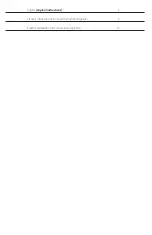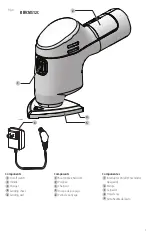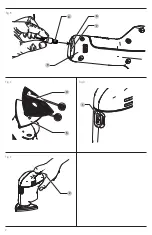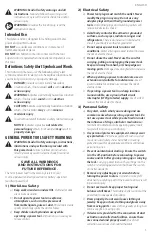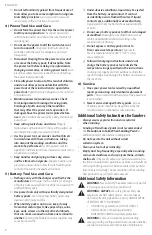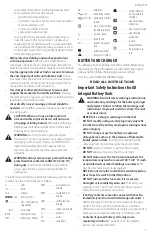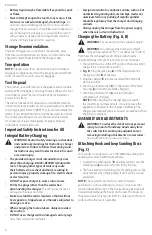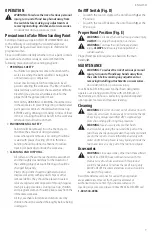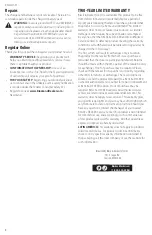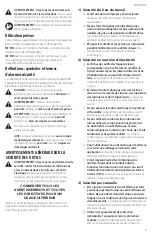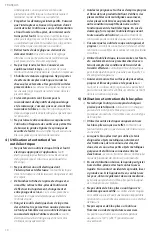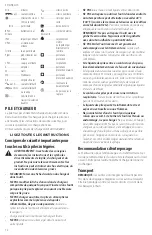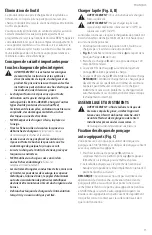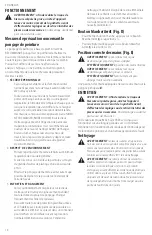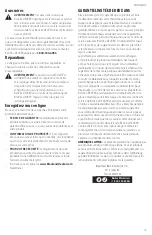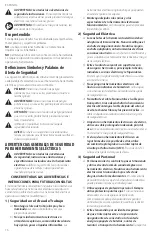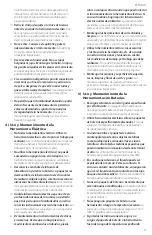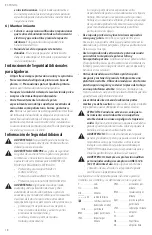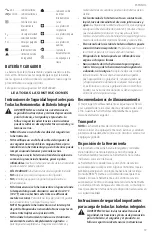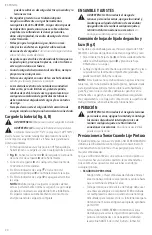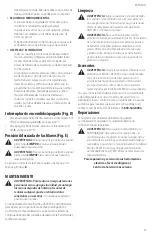
7
English
Accessories
WARNING:
Since accessories, other than those offered
by BLACK+DECKER, have not been tested with this
product, use of such accessories with this product
could be hazardous. To reduce the risk of injury, only
BLACK+DECKER recommended accessories should be
used with this product.
Recommended accessories for use with your product
are available at extra cost from your local dealer or
authorized service center. If you need assistance in
locating any accessory, please contact BLACK+DECKER call
1‑800‑544‑6986
.
Cleaning
WARNING:
Blow dirt and dust out of all air vents with
clean, dry air at least once a week. To minimize the risk
of eye injury, always wear ANSI Z87.1 approved eye
protection when performing this procedure.
WARNING:
Never use solvents or other harsh
chemicals for cleaning the non‑metallic parts of the
tool. These chemicals may weaken the plastic materials
used in these parts. Use a cloth dampened only with
water and mild soap. Never let any liquid get inside the
tool; never immerse any part of the tool into a liquid.
MAINTENANCE
WARNING: To reduce the risk of serious personal
injury, turn unit off and keep hands away from
the switch before making any adjustments or
removing/installing attachments or accessories.
An accidental start‑up can cause injury.
Your BLACK+DECKER power tool has been designed to
operate over a long period of time with a minimum of
maintenance. Continuous satisfactory operation depends
upon proper tool care and regular cleaning.
On/Off Switch (Fig. D)
• To switch the tool on, depress the on/off switch
1
at the
“I” position.
• To switch the tool off, depress the on/off switch
1
at the
”O” position.
Precautions to Take When Sanding Paint
Sanding of lead based paint is NOT RECOMMENDED due
to the difficulty of controlling the contaminated dust.
The greatest danger of lead poisoning is to children and
pregnant women.
Since it is difficult to identify whether or not a paint contains
lead without a chemical analysis, we recommend the
following precautions when sanding any paint:
1.
PERsOnAl sAFETY
‑
No children or pregnant women should enter the
work area where the paint sanding is being done
until all clean up is completed.
‑
A dust mask or respirator should be worn by all
persons entering the work area. The filter should be
replaced daily or whenever the wearer has difficulty
breathing. See your local hardware store for the
proper NIOSH‑approved dust mask.
‑
NO EATING, DRINKING or SMOKING should be done
in the work area to prevent ingesting contaminated
paint particles. Workers should wash and clean up
BEFORE eating, drinking or smoking. Articles of food,
drink, or smoking should not be left in the work area
where dust would settle on them.
2.
EnViROnMEnTAl sAFETY
‑
Paint should be removed in such a manner as to
minimize the amount of dust generated.
‑
Areas where paint removal is occurring should be
sealed with plastic sheeting of 4 mils thickness.
‑
Sanding should be done in a manner to reduce
tracking of paint dust outside the work area.
3.
ClEAning AnD DisPOsAl
‑
All surfaces in the work area should be vacuumed
and thoroughly cleaned daily for the duration of
the sanding project. Vacuum filter bags should be
changed frequently.
‑
Plastic drop cloths should be gathered up and
disposed of along with any dust chips or other
removal debris. They should be placed in sealed
refuse receptacles and disposed of through regular
trash pick‑up procedures. During clean up, children
and pregnant women should be kept away from the
immediate work area.
‑
All toys, washable furniture and utensils used by
children should be washed thoroughly before being
used again.
OPERATION
WARNING: To reduce the risk of serious personal
injury, turn unit off and keep hands away from
the switch before making any adjustments or
removing/installing attachments or accessories.
An accidental start‑up can cause injury.
Proper Hand Position (Fig. E)
WARNING:
To reduce the risk of serious personal injury,
ALWAYS
use proper hand position as shown.
WARNING:
To reduce the risk of serious personal
injury,
ALWAYS
hold securely in anticipation of a
sudden reaction.
Proper hand position requires one hand on the main
handle
2
.


